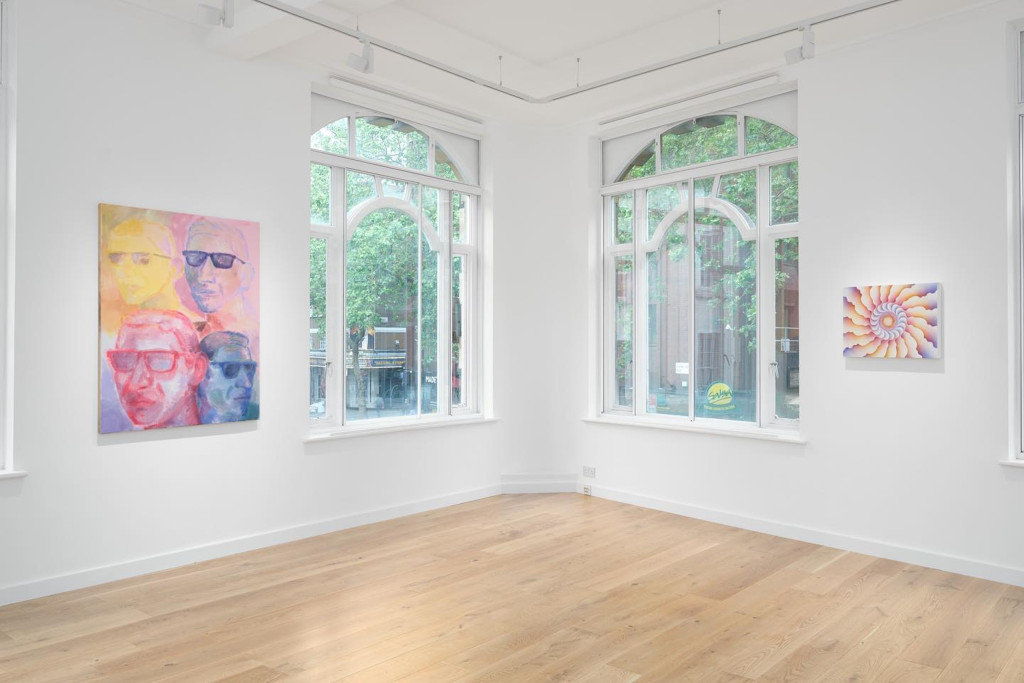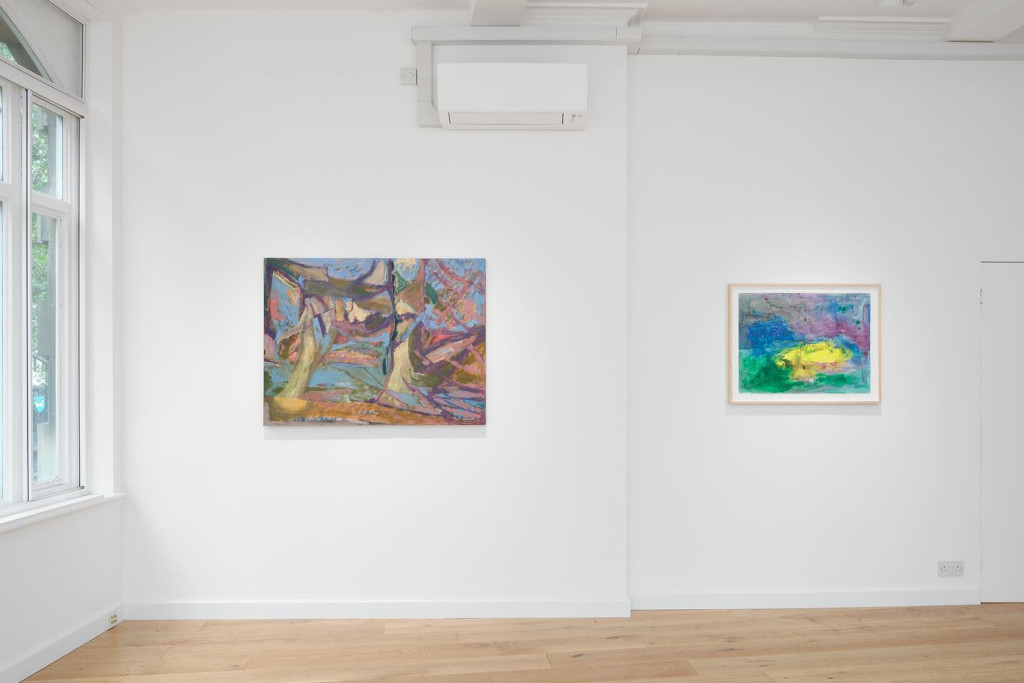A group exhibition with new works by Winston Branch, James Ferguson-Rose, Alex Gibbs, Neill Kidgell and Eddie Ruscha.
If you would like a preview catalogue, please email: cedric@cedricbardawil.com


This Summer, Cedric Bardawil is delighted to present Wayfarer: a group exhibition featuring five dynamic contemporary artists. Spanning works fresh from the studio like James Ferguson-Rose’s Field Edge (2023) to Winston Branch’s majestic Untitled (2012-13)—a painting exhibited at the Whitworth, Manchester last year—the exhibition establishes a dialogue between abstract form and representation, each composition playfully obscuring what lies beyond its surface of fragmented forms. Rendered in dazzling colour palettes, the works revel in chromatic brilliance, whether this be the radiant, kaleidoscopic terrains of Eddie Ruscha’s Spectral Blossom (2022) and Sunborn 1 (2023), or the luminous mosaic fragments of Neill Kidgell’s Obstacle (2022) and Weather Painting 2 (2022). In Alex Gibbs’ English Whimsy and Me (2022), colour is employed as a device for categorisation, a technique which also manifests his Pick a direction, walk in it, get lost, find yourself again (2022): his sunglasses- clad character lending the exhibition the title Wayfarer.
Field Edge is a majestic example of James Ferguson-Rose’s ability to conflate the past and present. The work presents us with two hedgerow tree trunks, their fractured silhouettes give way to a patchwork of abstracted, angular forms. Surrounding the trees, a pattern of linear shapes suggests a mesh of branches, meanwhile flashes of sky blue and mauve recall a hazy horizon, hinting to the glow of twilight or fogginess of dawn. A keen wayfarer outside the studio, Ferguson-Rose documents the landscapes he encounters in the English countryside. In Field Edge, he presents us with the record of several journeys through Northumberland, depicting in part what he recalls as a ‘quiet, unremarkable field in a quiet, unremarkable corner’ of the Northern county. Quick and stifled, the brushstrokes lend the work an otherworldly quality, a device which suggests the haziness of memory. ‘This painting is not about stillness and being in one place’, Ferguson-Rose comments, ‘It is a record of … the constantly moving landscape that defines them, with the paintings taking the journey again and again, growing over time in the studio until they settle as somewhere I know that I have been and experienced’. Equally inspired by his immediate surroundings— in this case the urban landscape of South East London where he lives and works—is British artist Neill Kidgell. For Kidgell, however, elements from the outside world function as mere catalysts for the process of making, the work’s visual effect taking precedence over its subject matter and source material. Indeed, this self-referential approach manifests poignantly in Obstacle and Weather Painting 2, works in which the artist’s complete painting process—replete with traces of erasure, accidents and reworking—is laid bare. Rendered on an intimate scale, Obstacle presents us with an array of clustered fragments, the angular orange form at the centre recalling a plastic construction barrier found on the street. Despite its quasi-familiar shape, this form came about accidentally, reflecting Kidgell’s process of painting with no plan or end point in mind. In Weather Painting 2, we are presented with an equally alluring mosaic of forms, their simple, geometric shapes straddling abstraction and representation. ‘The compositions often look like a collection of fragments, a detail of a larger image, or suggest environments, structures and objects glimpsed or caught in a state of change or transition’, Kidgell comments, ‘Through this approach to my practice, I explore the relationships between recognition and ambiguity, intuitive and conscious gestures, and painting and drawing as material thing and image’.
Also employing simple pictorial tools in his practice is artist Alex Gibbs. In Pick a direction, walk in it, get lost, find yourself again, Gibbs presents us with a portrait of himself sporting a pair of Wayfarer sunglasses, his visage pasted in bright yellow, pastel pink, maroon and midnight blue across each quadrant of the picture plane. Here, contrasting colours are employed as a means of categorisation, enabling him to present multiple versions or identities of oneself. Based on a period he spent in Seoul with his family at the end of 2021, the work is inspired by walks the artist took around the city with his three-month- old son Ivor, usually drifting him off to sleep. Each day, he would step out the door, choose a direction, start walking, get lost, and find himself again. A self-confessed nomad, Gibbs’ aimless strolls around Seoul recall Ferguson- Rose’s journeys across Northumberland, both artists swept away by the magnitude of their surroundings. ‘It was a wonderful way to see the city’, Gibbs proclaims, ‘This then became a song that I would sing to [my son]. I had many such songs. Though the song referred to locating oneself geographically, using it as the title of this painting creates the suggestion of finding oneself spiritually’. A lover of music, and an avid musician himself, Gibbs’ English Whimsy and Me is a painting based on British 1980s and ‘90s rock music. Rendered in a vivid, hallucinatory colour palette, the work presents us with Genesis members Peter Gabriel and Phil Collins, a generic ‘90s guitar player and another character, later confessed to be Gibbs himself. Here, Collins sports a bright yellow Hawaiian shirt, meanwhile Gabriel appears as one of his alter-egos Magog, sporting the red headpiece he wore at the end of the song Supper’s Ready. ‘I like music and painting that brings out feelings in me’, Gibbs once told Cedric Bardawil, ‘That is not all the music and painting that I like, of course, but it is a special—and persuasive—force within me. That it then seeps into the paintings I make is only natural’.
Also enabling music to feed into his art is LA- based artist and musician Eddie Ruscha. ‘I always have music in my head when I’m painting’, he has told Cedric, ‘and I’m always seeing something visual when I’m making music’. Son of Pop Art icon Ed Ruscha, Eddie’s dreamy, hallucinatory motifs pulse with rhythmic energy, each pictorial pattern as symphonic as the next. In Spectral Blossom and Sunborn 1, we are presented with the artist’s seminal psychedelic motifs, their airbrushed, symmetrical forms appear suspended in a state of flux. Rendered in hazy tones of pink, orange, lilac and green, the works can be considered as a homage to the artist’s hometown of Los Angeles, the cyclical and centrifugal rays of Sunborn 1 evoking heady sunshine of the West Coast. ‘I would say that California has always had me in its grip’ Ruscha has commented, ‘It’s really the end of the line before time starts again. It’s got a sunset embedded in it.’ Also inspiring his compositions are the kaleidoscopic dance sequences of Busby Berkeley, their shifting forms recalling the orbit of gyrating bodies in Footlight Parade (1933). Recalling the equally sumptuous surfaces of Judy Chicago, Spectral Blossom and Sunborn 1 transport us into Ruscha’s surreal and mesmerising pictorial universe. Also enlivened with rhythmic vitality is Winston Branch’s Untitled, a work notably featured in the Whitworth Art Gallery, Manchester’s group exhibition Althea McNish: Colour is Mine last year. Rendered in glorious swaths of emerald green, violet and cobalt blue, the work presents us with a tactile abstract terrain, a central spurt of bright yellow hints to a sun over landscape. Born in St Lucia in 1947, Branch moved to London in his teens and enrolled at The Slade School of Fine Art, after which he was awarded the prestigious British Prix de Rome in 1971, an award which led to a residency at the British School in the Italian capital; followed by an Artists-in-Berlin ‘DAAD’ fellowship in 1976 and the John Simon Guggenheim fellowship in 1978. During this period, he took up teaching posts at the Slade, Chelsea College of Arts, and other universities in London, before he moved to California and adopted a professorship at the University of California, Berkeley. Indeed, Branch considered these academic endeavours fundamental to his practice. Meanwhile, he maintained a stringent painting practice that, from the ‘80s, abandoned figuration for an ‘abstraction inspired by nature’. In Untitled, Branch presents us with the product of a journey begun four decades earlier, its richly worked surface evoking his longstanding investigation into colour and light. ‘The works I have been making over the last many years are questioning what we see and how the mind responds to it’, Branch has commented, ‘Therefore, it is about feeling through the senses. For me, colour and light is feeling. The intimacy of the work should be intoxicating, like an ejaculation of the senses—euphoric!’.

